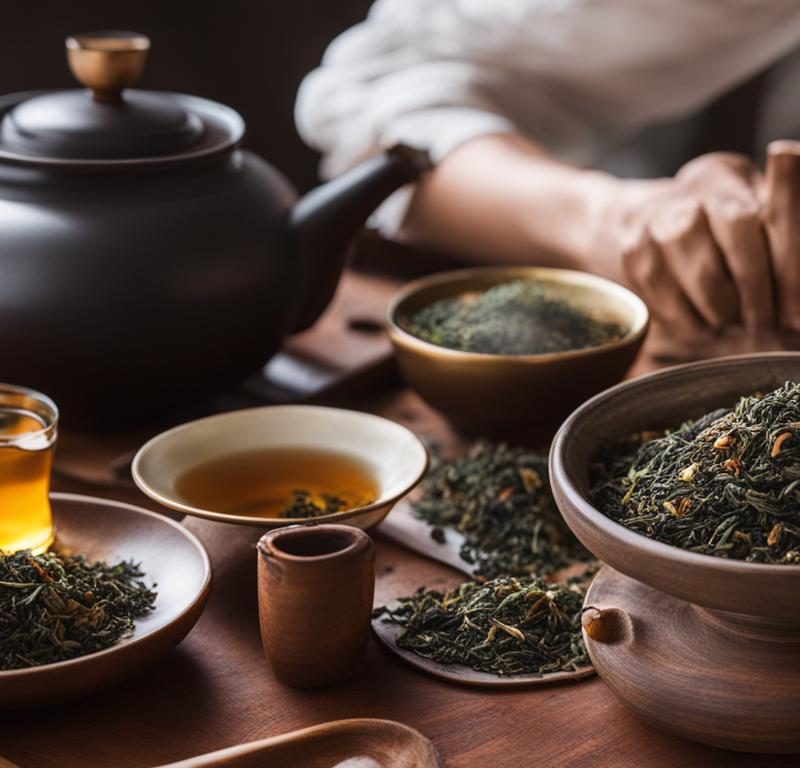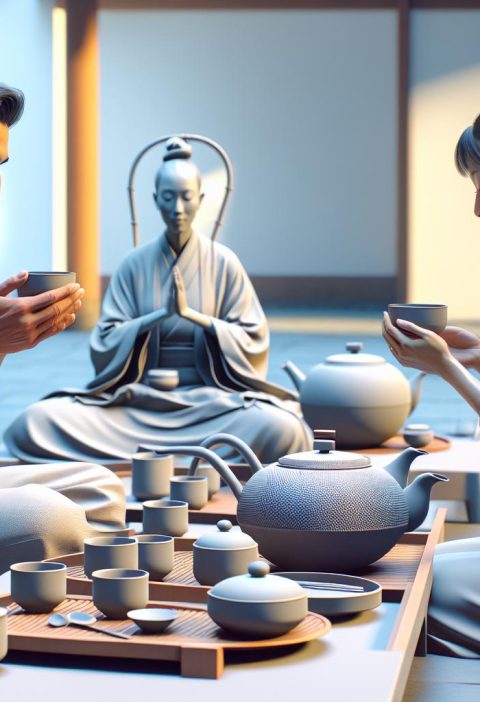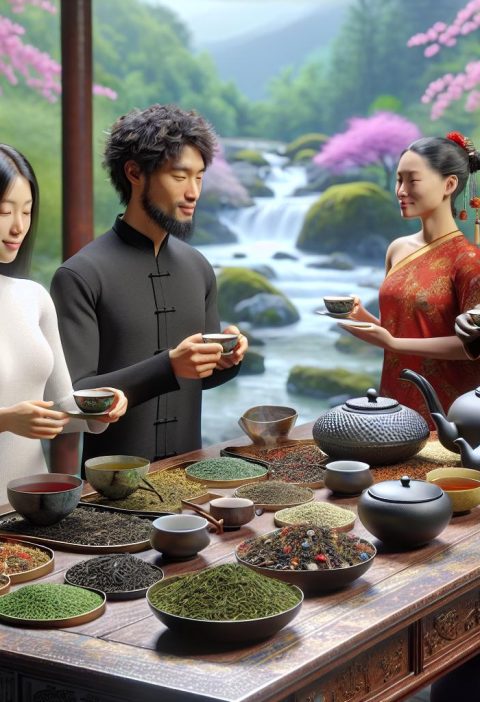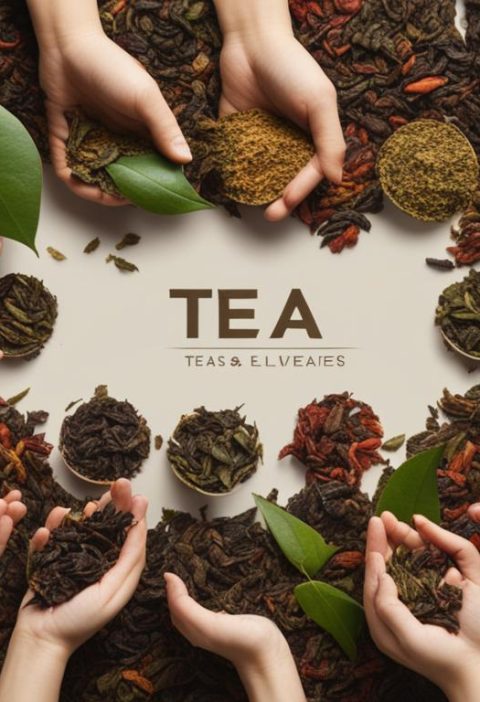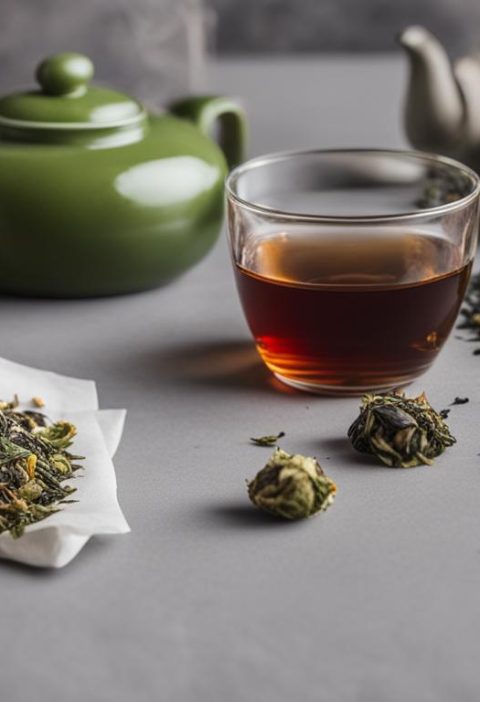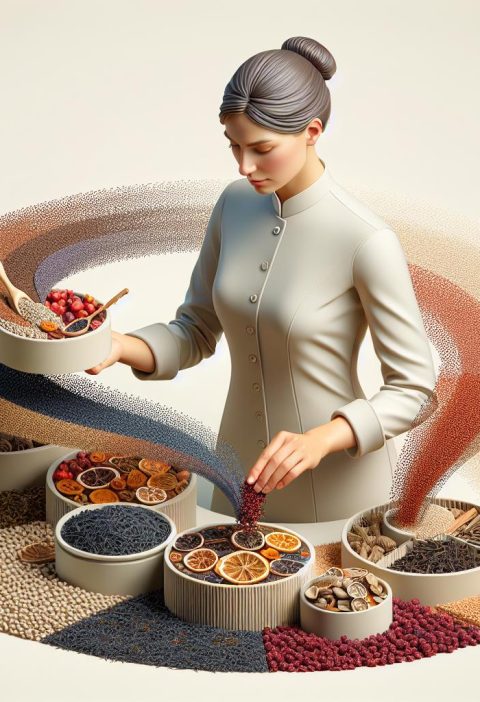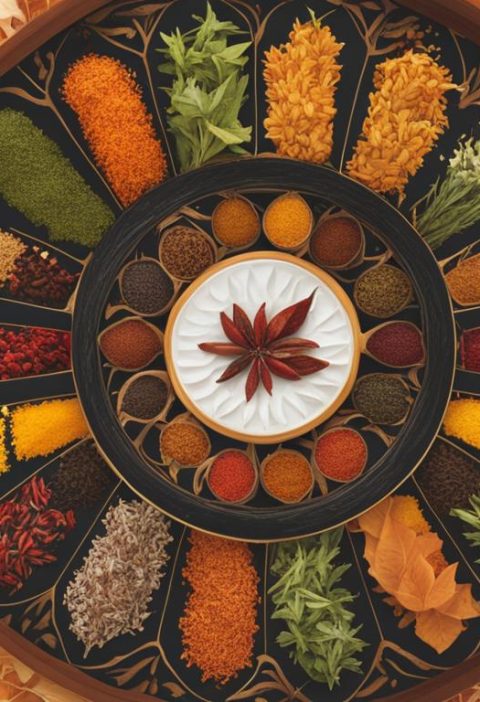Tea tasting is an art that allows enthusiasts to fully savor the flavors and nuances of premium loose leaf teas. With expert tea tasting notes, loose leaf enthusiasts can discover the best flavors and gain valuable insights into their favorite teas. This article will delve into the key aspects of tea tasting and provide tips and guidance for enthusiasts to enhance their tea drinking experience.
Understanding the Elements of Tea Tasting
Tea tasting involves evaluating various elements of the tea, such as flavor, body, aroma, finish, and liquor color. These elements help identify the complexity and quality of the tea. By understanding the flavor profiles and experimenting with different brewing techniques, tea enthusiasts can uncover new dimensions of taste and enhance their appreciation for loose leaf teas.
Key Takeaways:
- Tea tasting involves evaluating flavor, body, aroma, finish, and liquor color
- Understanding flavor profiles can help enthusiasts explore new dimensions of taste
- Experimenting with brewing techniques enhances appreciation for loose leaf teas
Understanding the Elements of Tea Tasting
Tea tasting is an art that allows us to appreciate the rich flavors and nuances of loose leaf teas. To fully grasp the complexities and qualities of tea, it’s essential to understand the key elements involved in the tasting process. By evaluating factors such as flavor, body, aroma, finish, and liquor color, we can uncover the true beauty of each cup.
Brewing Loose Leaf Tea Guide
Before we dive into the elements of tea tasting, let’s start with the basics: brewing loose leaf tea. A proper brewing technique is crucial to bringing out the best flavors in your cup. Here’s a simple guide to get you started:
- Choose high-quality loose leaf tea that suits your taste preferences.
- Measure the appropriate amount of tea leaves based on the serving size.
- Heat water to the recommended temperature for the specific type of tea.
- Steep the tea for the recommended time, allowing the flavors to fully develop.
- Strain the tea and pour it into a teacup, ready for tasting.
Loose Leaf Tea Flavor Profiles
Each loose leaf tea has its own unique flavor profile, ranging from delicate and floral to bold and robust. Understanding these flavor profiles can help us appreciate the nuances and make informed choices when selecting teas:
| Type of Tea | Flavor Profile |
|---|---|
| Green Tea | Grassy, vegetal, subtle sweetness |
| Black Tea | Malty, full-bodied, sometimes with floral or fruity notes |
| Oolong Tea | Floral, fruity, with varying levels of oxidation |
| White Tea | Delicate, subtle, with light floral notes |
| Pu-erh Tea | Earthy, fermented, with hints of sweetness and aged flavors |
Loose Leaf Tea Tasting Tips
When it comes to tasting loose leaf tea, there are a few tips that can enhance your experience:
- Use a clean, white teacup to evaluate the color and clarity of the liquor.
- Inhale deeply and appreciate the aroma of the steeped leaves before taking a sip.
- Sip the tea slowly, allowing the flavors to unfold on your palate.
- Pay attention to the texture and body of the tea, noting its mouthfeel.
- Consider the finish of the tea, noting any lingering flavors or aftertastes.
By following these tips and exploring the flavor profiles of different loose leaf teas, you can truly immerse yourself in the world of tea and enhance your tea tasting journey.
Exploring Tea Varieties and Origins
The quality and characteristics of loose leaf teas are influenced by their varieties and origins. Each type of tea, whether it’s black, green, white, oolong, or pu-erh, undergoes a different process of oxidation and fermentation, resulting in distinct flavors and aromas. By exploring different tea varieties and understanding their origins, enthusiasts can discover their preferred tea styles and explore new brands recommended by experts.
Tea Varieties and Flavor Profiles
Tea varieties play a significant role in determining the flavors and profiles of loose leaf teas. Here are some popular tea varieties and their unique characteristics:
- Black Tea – Known for its bold and robust flavors, black tea undergoes full oxidation, resulting in deep and rich flavors.
- Green Tea – Renowned for its fresh and grassy flavors, green tea is minimally oxidized, maintaining its natural antioxidants.
- White Tea – Prized for its delicate and subtle flavors, white tea undergoes minimal processing, allowing its natural sweetness to shine through.
- Oolong Tea – Offering a range of flavors between black and green tea, oolong tea is partly oxidized, resulting in complex and floral notes.
- Pu-erh Tea – Known for its earthy and aged flavors, pu-erh tea undergoes a unique fermentation process, imparting distinct and mellow qualities.
These various tea varieties provide a broad spectrum of flavors, allowing enthusiasts to explore different taste profiles and find their preferred tea styles.
Tea Origins and Terroir
The terroir, or the environment in which tea plants are grown, greatly influences the taste and character of the tea. Different regions around the world have unique geographical and climatic conditions that result in distinctive tea flavors. Some renowned tea-producing regions include:
| Region | Notable Tea Varieties |
|---|---|
| China | Dragon Well, Keemun, Tie Guan Yin |
| India | Assam, Darjeeling, Nilgiri |
| Japan | Matcha, Sencha, Gyokuro |
| Sri Lanka | Ceylon |
Exploring teas from different origins allows enthusiasts to experience the regional nuances and appreciate the diverse flavors that each terroir offers.
Experts often provide valuable insights and recommendations on premium loose leaf tea brands. Reading their reviews and recommendations can guide enthusiasts towards exceptional teas and expand their tea tasting journey.
Evaluating Leaf Appearance
When it comes to loose leaf tea, visual cues can reveal a lot about the quality of the tea leaves. Factors such as color, shape, size, and consistency offer valuable insights into the care taken during harvesting and processing.
Loose leaf tea enthusiasts understand the importance of examining the appearance of tea leaves before brewing. By observing these characteristics, enthusiasts can determine whether the tea is of high quality and worthy of their attention.
In the loose leaf tea enthusiasts community, members come together to share their experiences and discuss the visual aspects of tea leaves. This online community provides a platform where enthusiasts can exchange knowledge and support each other in identifying premium teas based on their appearance.
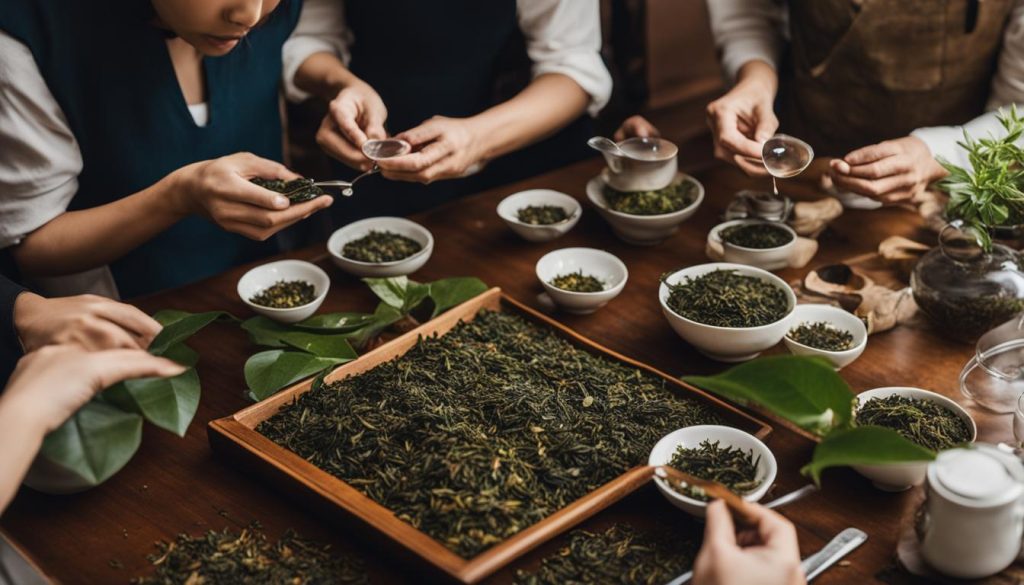
Assessing Aroma and Fragrance
The aroma of dry tea leaves offers a preview of the flavors and experience that await when the tea is brewed. High-quality teas have distinctive and inviting fragrances that reflect their specific type. By learning how to assess the quality of tea through its aroma, enthusiasts can anticipate the character and complexity of the tea before even taking a sip.
When evaluating the aroma of loose leaf tea, pay attention to the following:
- Freshness: Aroma is a great indicator of the tea’s freshness. Opt for teas with a strong and vibrant fragrance.
- Intensity: The intensity of the aroma can vary depending on the type of tea. Some teas have a subtle fragrance, while others are more pronounced.
- Specific Notes: Take note of any particular scents that you can identify in the aroma, such as floral, fruity, earthy, or herbal notes. These notes can provide valuable insights into the tea’s flavor profile.
To fully experience the aroma, take a moment to inhale the fragrance of the dry tea leaves before brewing. You can also gently warm the leaves in your hands to release the aromas further.
Keep in mind that aroma is just one aspect of the tea tasting experience. It should complement the other elements, such as flavor and texture, to create a harmonious and enjoyable tea drinking experience.
Brewing the Perfect Cup of Tea
When it comes to brewing loose leaf tea, attention to detail and understanding the key factors are essential for achieving the perfect cup. By considering the quality of the tea, the water used, and the teaware, you can enhance the flavor profile and elevate your tea drinking experience.
- Choose Loose Leaf Tea: Opt for loose leaf tea instead of tea bags to maximize the flavor and aroma. Loose leaf tea allows the leaves to fully expand and release their flavors during the brewing process.
- Water Temperature: Different types of tea require specific water temperatures to bring out the best flavors. Green teas generally prefer lower temperatures (around 175°F), while black teas benefit from hotter water (around 212°F). Oolong teas fall in between, typically brewed at around 195°F.
- Infusion Time: The infusion time varies depending on the type of tea and personal preferences. It’s important to follow the recommended steeping times to avoid bitterness or a weak flavor. Generally, black teas steep for 4-5 minutes, green teas for 2-3 minutes, and oolong teas for 3-4 minutes.
- Teaware: Using high-quality teaware enhances the overall tea tasting experience. Invest in a good teapot or a teacup with a strainer to maximize the infusion and ensure a smooth pour. Teaware made from materials like ceramic, glass, or clay can enhance the flavors and aromas of the tea.
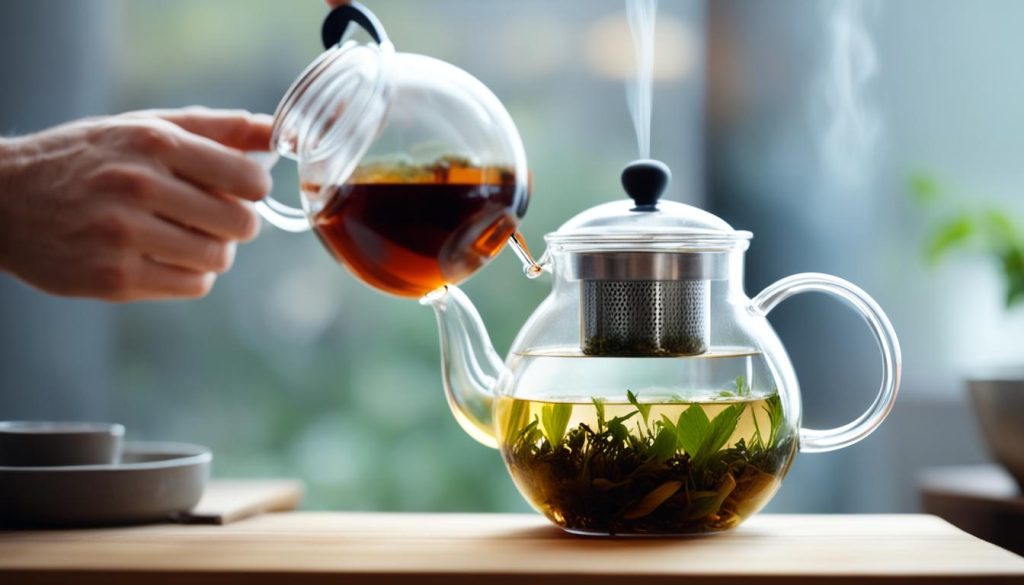
By paying attention to these brewing guidelines, you can consistently enjoy a cup of tea that is rich in flavor and aroma. Remember to experiment with different teas and brewing techniques to find your perfect cup.
Tea Tasting Tips and Rituals
Tea tasting is not just about savoring the flavors of loose leaf teas; it’s also a personal experience where enthusiasts develop their own rituals and preferences. Whether you’re a seasoned tea connoisseur or just starting your tea journey, here are some simple tea tasting tips to enhance your experience:
1. Use Freshly Drawn Water
When brewing your loose leaf tea, it’s essential to use freshly drawn water from the tap or a filtered source. This ensures that the water is oxygenated and free from any impurities that may affect the taste of your tea. Avoid using pre-boiled or stagnant water for the best flavor.
2. Use the Right Amount of Tea
The right amount of tea per person may vary depending on personal preference and the type of tea you’re brewing. As a general guideline, use approximately one teaspoon of loose leaf tea per 8-ounce cup of water. Adjust the amount to suit your taste and experiment to find the perfect balance.
3. Consider the Temperature of the Water
The temperature of the water used for brewing tea can significantly impact the flavor profile. Different teas require specific water temperatures to bring out their best qualities. For example, delicate green teas benefit from lower temperatures around 160°F (71°C), while robust black teas can handle boiling water at 212°F (100°C). Consult the brewing instructions for your specific tea to achieve optimal results.
Tea Tasting Rituals
As tea enthusiasts, we often develop rituals and traditions around our favorite teas. Some enthusiasts have specific teas they enjoy during certain times of the day or for special occasions. Others may have a preferred teaware or brewing method that adds to the ritualistic aspect of tea drinking. The loose leaf tea enthusiasts community is a great place to explore new ideas and rituals, share experiences, and discover the diverse world of loose leaf teas.
Recommended Loose Leaf Tea Tasting Ritual Accessories
| Accessory | Description |
|---|---|
| Tea Set | A complete tea set with a teapot, teacups, and a tea tray for an authentic tea tasting experience. |
| Tasting Cupping Set | A specialized set of porcelain or glass cups designed for professional tea tasting and aroma evaluation. |
| Tea Timer | A timer or smartphone app to ensure consistent brewing times and optimal extraction of flavors. |
| Tea Journal | A notebook or app to record your tea tasting notes, including flavor profiles, brewing methods, and personal preferences. |
| Tea Infusers | Various infuser devices, such as teapots with built-in infusers or individual tea infusers, to steep loose leaf teas without any mess. |
Having the right tea tasting accessories can enhance your tea-drinking ritual and help you fully appreciate the flavors and aromas of your favorite loose leaf teas. Remember, the key is to embrace your own unique tea tasting experience and let your senses guide you on a journey of exploration and delight.
Exploring Tea Blends and Pairings
Tea blends offer endless possibilities for flavor exploration and pairing. Enthusiasts can experiment with different combinations to create their own unique blends or explore the recommendations from experts and fellow tea enthusiasts. By trying out different tea blends and discovering the best flavor combinations, enthusiasts can elevate their tea tasting experience to new heights.
One popular tea blend is the classic Earl Grey, which combines black tea with the citrusy essence of bergamot. This blend offers a harmonious balance of boldness and fragrance, making it a favorite among tea connoisseurs. For those seeking a floral twist, a blend of green tea with jasmine blossoms creates a delicate and aromatic cup.
When it comes to pairings, tea blends offer the opportunity to create delightful combinations with food. For a rich and indulgent experience, pairing a robust black tea blend with dark chocolate can create a decadent flavor pairing. For a refreshing and light combination, a fruity herbal tea blend can complement a fresh fruit salad.
Exploring tea blends and pairings not only allows enthusiasts to discover new and exciting flavors but also enables them to tailor their tea experience to their personal preferences. Whether blending teas to create a customized flavor profile or pairing teas with complementary foods, the possibilities are limited only by one’s imagination.
Popular Tea Blends and Their Flavor Profiles
| Tea Blend | Primary Flavors |
|---|---|
| Earl Grey | Citrusy, bold, fragrant |
| Jasmine Green Tea | Floral, delicate, aromatic |
| Chai Tea | Spicy, robust, warming |
| Mint Herbal Tea | Cooling, refreshing, invigorating |
| Fruit Infusion | Sweet, fruity, vibrant |
Table: Popular Tea Blends and Their Flavor Profiles
The Popularity of Tea in Different Cultures
Tea is not only enjoyed in the United States but also deeply rooted in different cultures around the world. Each culture has its own unique tea traditions, serving styles, and preferred types of tea. Exploring the popularity of tea in different cultures can broaden the horizons of loose leaf tea enthusiasts, introducing them to new flavors, rituals, and perspectives on tea appreciation.
Japanese Tea Ceremony: An Artistic Ritual
One of the most famous tea traditions is the Japanese tea ceremony, also known as chanoyu. This centuries-old ritual combines elements of mindfulness, elegance, and harmony. Participants come together to appreciate the beauty of tea preparation and consumption. Matcha, a powdered green tea, is commonly used in the Japanese tea ceremony, creating a vibrant and intense flavor experience.
British Afternoon Tea: An Iconic Tradition
In the United Kingdom, afternoon tea is a cherished tradition that dates back to the 1800s. This delightful occasion involves enjoying a selection of fine teas, accompanied by finger sandwiches, scones, and pastries. Black teas, such as Earl Grey and English Breakfast, take center stage during the British afternoon tea, offering rich flavors and a comforting experience.
Chinese Gongfu Cha: The Art of Brewing
Gongfu Cha, meaning “making tea with skill,” is a Chinese tea ceremony known for its meticulous brewing techniques. This ceremony emphasizes the use of small teapots and multiple short infusions, allowing the flavors to unfold gradually. Chinese oolong teas, such as Tie Guan Yin and Da Hong Pao, are highly regarded in Gongfu Cha for their complex flavors and aroma.
Moroccan Mint Tea: A Refreshing Tradition
In Morocco, tea holds a special place in social gatherings and hospitality. The Moroccan mint tea, also known as “Atay,” is a refreshing blend of green tea, fresh mint leaves, and sugar. This sweet and fragrant tea is served in small glasses and poured from a height, creating a frothy layer. The Moroccan mint tea is a symbol of hospitality and a way to welcome guests.
Indian Chai: A Spiced Delight
In India, chai holds a significant presence in everyday life. Indian chai is a spiced tea made from a blend of loose black tea leaves, milk, spices such as cardamom, ginger, and cinnamon, and sweetened with sugar. Chai is often enjoyed in small clay cups called “kulhads” or in larger mugs. It is a comforting and invigorating beverage that brings people together.
Exploring these and many other tea cultures can provide loose leaf tea enthusiasts with a deeper appreciation for the diverse array of flavors, rituals, and experiences associated with tea. By embracing the richness of tea traditions from around the world, enthusiasts can expand their taste preferences and discover new premium loose leaf tea brands to indulge in.
| Culture | Tea Tradition | Preferred Types of Tea |
|---|---|---|
| Japanese | Tea Ceremony (Chanoyu) | Matcha |
| British | Afternoon Tea | Earl Grey, English Breakfast |
| Chinese | Gongfu Cha | Tie Guan Yin, Da Hong Pao |
| Moroccan | Mint Tea (Atay) | Green Tea with Mint |
| Indian | Chai | Black Tea with Spices (Cardamom, Ginger, Cinnamon) |
The Importance of Teaware
The choice of teaware plays a significant role in the tea tasting experience. Using high-quality teaware can enhance the aroma, flavor, and overall enjoyment of premium loose leaf teas. When selecting teaware, it’s important to consider the materials, design, and functionality that will best complement your tea drinking rituals.
Materials:
Teaware can be made from various materials such as porcelain, ceramic, glass, or cast iron. Each material has its own unique characteristics that can influence the taste and presentation of the tea. For example, porcelain and ceramic teaware are known for their ability to retain heat and showcase the vibrant colors of the tea liquor. Glass teaware, on the other hand, allows for visual appreciation of the tea leaves unfurling during steeping. Cast iron teapots, with their excellent heat retention properties, are ideal for brewing rich and robust teas.
Design:
The design of teaware can enhance the aesthetic appeal and functionality of the tea tasting experience. Whether it’s a traditional Asian-inspired teapot, a modern and minimalist teacup, or a unique teapot with intricate patterns, the design of teaware adds an element of elegance and personal style to tea rituals. Teaware with ergonomic handles and spouts facilitates easy pouring and a comfortable grip, making the brewing process seamless and enjoyable.
Functionality:
Teaware should also be chosen based on its functionality in facilitating the brewing and serving of loose leaf teas. Teapots with built-in infusers or removable strainers make it convenient to steep the tea leaves and separate them from the liquid. Teacups with wide rims allow for an enhanced aroma while sipping, while cups with lids can help retain heat during the tasting process. Additionally, teaware that is dishwasher-safe or easy to clean can save time and effort in maintenance.
Exploring premium loose leaf tea brands that offer exquisite teaware collections can be an exciting journey in itself. By investing in high-quality teaware, tea enthusiasts can elevate their tea tasting rituals to a new level of sophistication and enjoyment.
Taking Time for Tea
In today’s fast-paced world, we often find ourselves caught up in the hustle and bustle of daily life. But taking the time to enjoy a cup of tea can be a simple yet meaningful act of self-care. As loose leaf tea enthusiasts, we understand the importance of slowing down, connecting with our senses, and savoring the moment.
By embracing the tea tasting experience, we allow ourselves to step away from the chaos and immerse ourselves in the tranquility of tea. Each sip becomes a journey, as we explore the intricate flavors, aromas, and textures that premium loose leaf teas have to offer. It’s an opportunity to truly engage our senses and indulge in a moment of pure bliss.
Joining the loose leaf tea enthusiasts community further enhances this experience. It provides a supportive and inspiring environment where we can connect with fellow tea lovers who share our passion. In this community, we can exchange knowledge, share our favorite teas, and discover new gems from premium brands recommended by enthusiasts just like us.
So let’s take a moment, brew a cup of our favorite loose leaf tea, and savor the tranquility in each sip. Because in the world of tea, time slows down, and every cup is a reminder to indulge in the simple pleasures that bring us joy.
